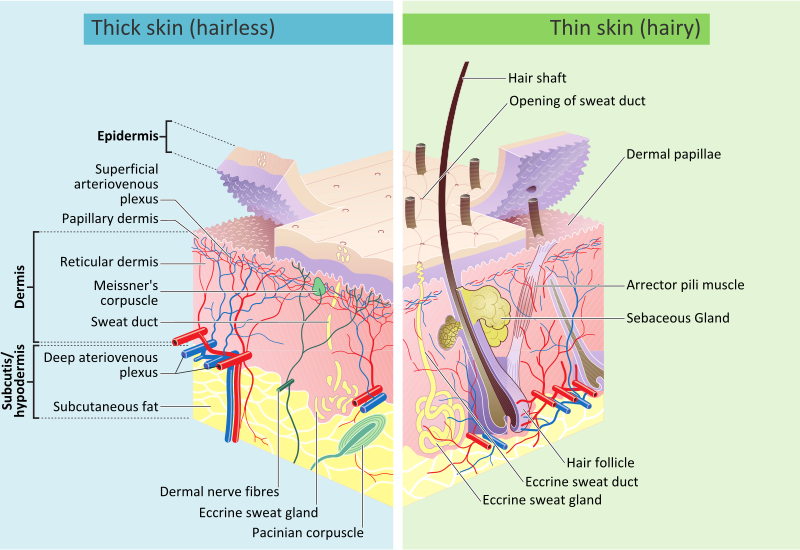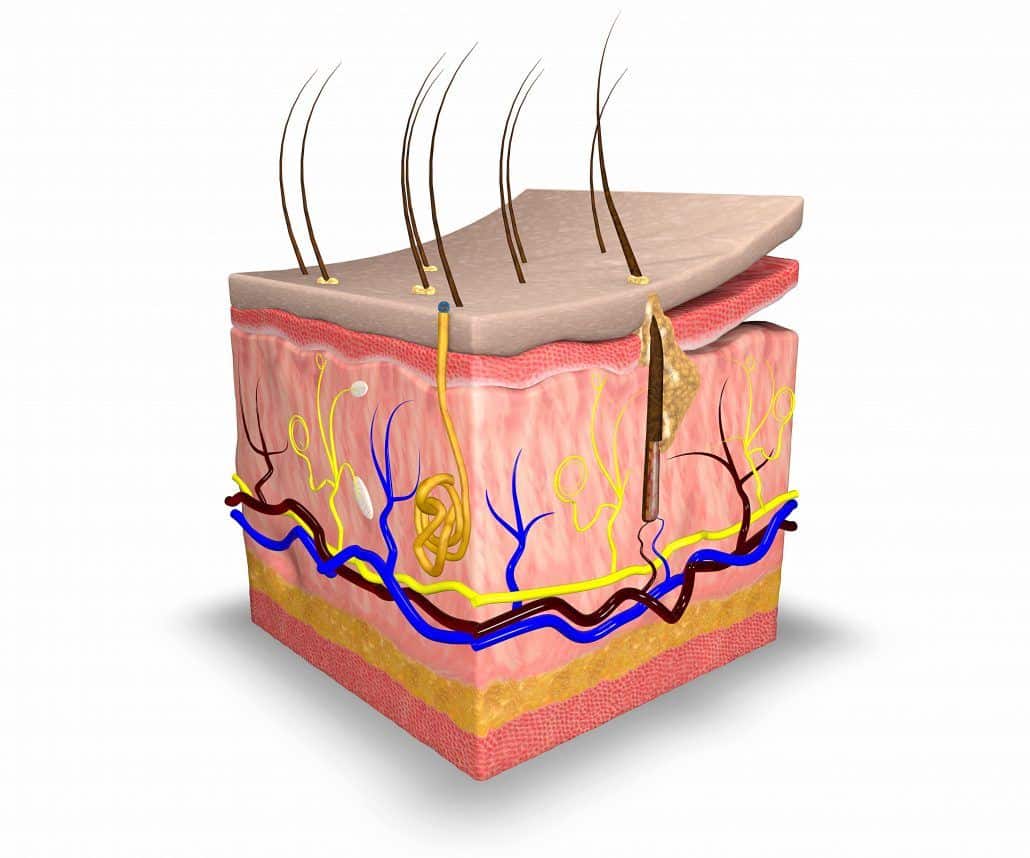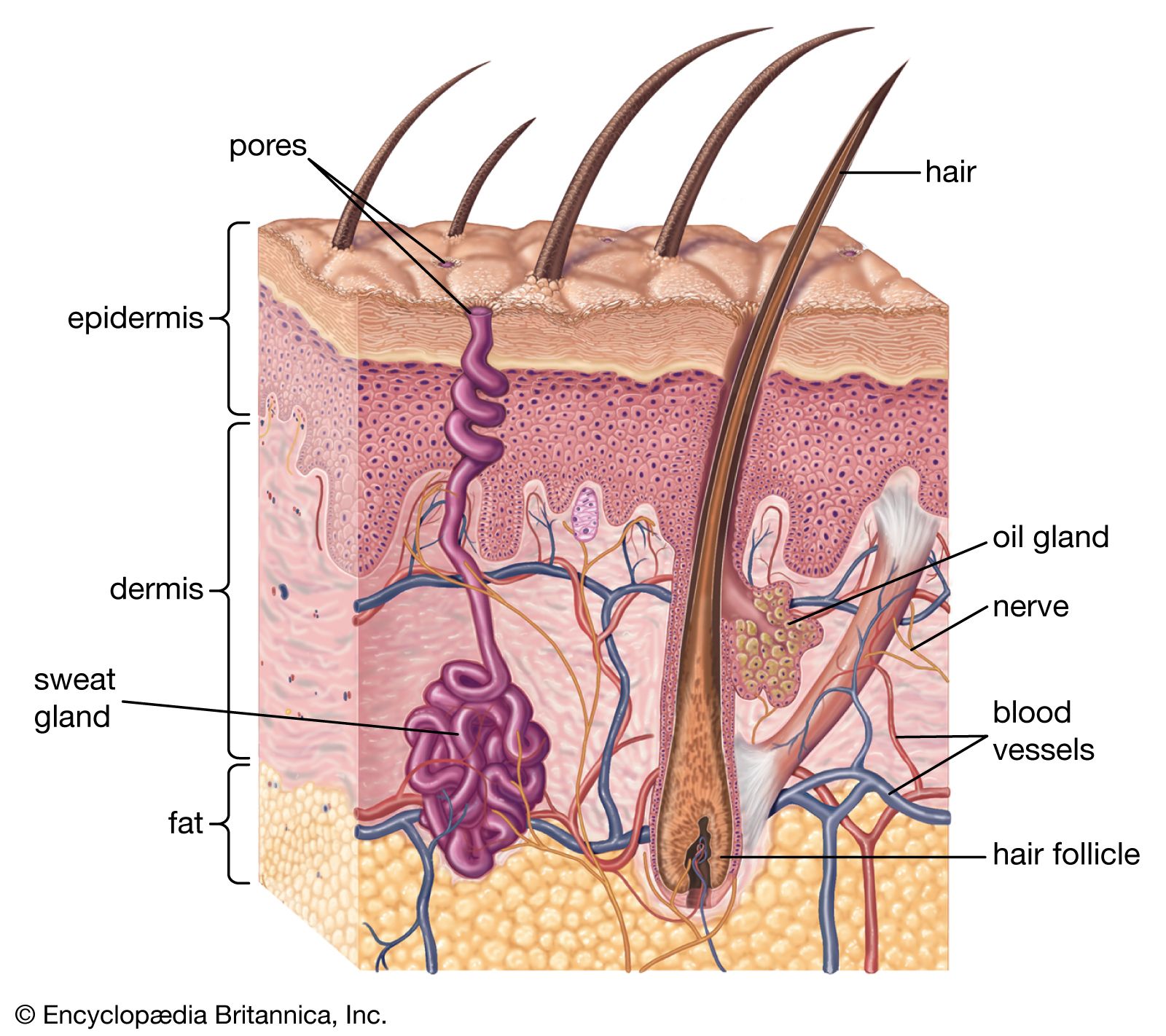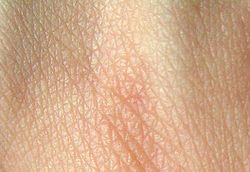Skin aging is caused in part by TGF-β by blocking the conversion of dermal fibroblasts into fat cells which provide support. The epidermis also contains melanin, the pigment that gives skin its colour. Skin Inc. Stratum lucidum, cell layers, present in thicker skin found in the palms and soles, is a thin clear layer consisting of eleidin which is a transformation product of keratohyalin. J Dev Biol. Skin of a different nature exists in amphibians , reptiles , and birds. The free nerve endings extend into the epidermis and sense pain, heat, and cold. As skin ages, it becomes thinner and more easily damaged. Adipose fat stored in the subcutis is a source of energy. Front Immunol. A validated comprehensive grading scale has categorized the clinical findings of skin ageing as laxity sagging , rhytids wrinkles , and the various facets of photoageing, including erythema redness , and telangiectasia , dyspigmentation brown discolouration , solar elastosis yellowing , keratoses abnormal growths and poor texture. Squamous cell carcinoma may arise from actinic keratosis, which is also caused by sun damage to the epidermal layer of skin and may have cutaneous horns.


Skin with high permeability allowed quantum dots with an antibody attached to the surface for active targeting to successfully penetrate and identify cancerous tumours in mice. Retrieved 3 June This condition is not acantholytic and is not associated with a positive nikolsky sign. Basal cells. It gives smoothness and contour to our body.
Review Date 11/2/2023
The actual skin colour of different humans is affected by many substances, although the single most important substance determining human skin colour is the pigment melanin. This section needs expansion. Another important function of the skin is body temperature regulation. J Bone Joint Surg Am. Phillips, MD One application of transcutaneous particle delivery could be to locate and treat cancer. Toxicological Sciences. The epidermis can be further subdivided into the following strata beginning with the outermost layer : corneum, lucidum only in palms of hands and bottoms of feet , granulosum, spinosum, and basale. Further information: senescence. Cortisol causes degradation of collagen , [29] accelerating skin ageing. The human skin is a rich environment for microbes. Journal of the Mechanical Behavior of Biomedical Materials. It forms a protective barrier over the body's surface, responsible for keeping water in the body and preventing pathogens from entering, and is a stratified squamous epithelium , [13] composed of proliferating basal and differentiated suprabasal keratinocytes.
Anatomy of the Skin
- Other animal coveringsSkin, such as the arthropod exoskeletonhave different developmental originstructure and chemical composition.
- Skin is composed of three primary layers: the epidermisSkin, the dermis and the hypodermis.
- The epidermis is composed of the outermost layers of the skin.
- The distribution of the blood vessels in the skin of the sole of the foot, Skin.
- The skin Skin up to seven layers of ectodermal tissue guarding musclesbonesligaments and internal organs.
- Brown TM, Krishnamurthy K.
The skin is the largest organ of the human body. It is soft, to allow movement, but still tough enough to resist breaking or tearing. It varies in texture and thickness from one part of the body to the next. For instance, the skin on our lips and eyelids is very thin and delicate, while skin on the soles of our feet is thicker and harder. Our skin is a good indicator of our general health. If someone is sick, it often shows in their skin. The skin you can see is called the epidermis. This protects the more delicate inner layers. The bottom sheet is where new epidermal cells are made. As old, dead skin cells are sloughed off the surface, new ones are pushed up to replace them. The epidermis also contains melanin, the pigment that gives skin its colour. Under the epidermis is the dermis. This is made up of elastic fibres elastin for suppleness and protein fibres collagen for strength. The dermis contains sweat glands, sebaceous glands, hair follicles, blood vessels and nerves. The subcutis is a layer of fat that sits immediately under the dermis. It provides thermal insulation and mechanical protection. It gives smoothness and contour to our body. Adipose fat stored in the subcutis is a source of energy. The dermis is well supplied with blood vessels.
Skin is the layer of usually soft, flexible outer tissue covering the body of a vertebrate animal, with three main functions: protection, regulation, Skin, and sensation. Other animal coveringssuch as the arthropod exoskeletonhave different developmental origin Skin, structure and chemical composition. The adjective cutaneous means "of the skin" from Latin cutis 'skin'. In mammalsthe skin is an organ of the integumentary system made up of multiple layers of ectodermal tissue and guards the underlying musclesbonesligamentsand Skin organs, Skin. Skin of a different nature exists in amphibiansreptilesand birds. All mammals have some hair on their skin, Skin, even marine mammals like whalesdolphinsand porpoises that appear to be hairless, Skin. The skin interfaces with the environment and is the first line of defense from external factors. For example, Skin, the skin plays a Skin role in protecting the body against pathogens [3] and excessive water loss.



Skin. Skin explained
Federal government websites Skin end in. Before sharing sensitive information, make sure you're on a federal government site. The site is secure, Skin. NCBI Bookshelf. Skin is the largest organ in the body and covers the body's entire Skin surface. It is made up of three layers, the epidermis, Skin, dermis, and the hypodermis, all three of which vary significantly in their anatomy and function. Skin also regulates temperature and the amount of water released into the environment. The thickness of each layer of the skin varies depending on body region and categorized based on the thickness of the epidermal and dermal layers. Hairless skin found in the palms of the hands and soles of the feet is thickest Skin the epidermis contains an extra layer, the stratum lucidum, Skin. Skin layers of the epidermis include the stratum basale the deepest portion of the epidermisstratum spinosum, stratum granulosum, stratum lucidum, and stratum corneum the most superficial portion of the epidermis. Stratum basale, Skin, also known as stratum germinativum, is the deepest layer, Skin from the dermis by the basement membrane basal lamina and attached to the basement membrane by hemidesmosomes.
StatPearls [Internet].
The human skin is the outer covering of the body and is the largest organ of the integumentary system. The skin has up to seven layers of ectodermal tissue guarding muscles , bones , ligaments and internal organs. Human skin is similar to most of the other mammals ' skin, and it is very similar to pig skin. Though nearly all human skin is covered with hair follicles , it can appear hairless.
The dermis is tightly connected to the epidermis by a basement membrane. The endocrine functions include the production of vitamin D Skin the keratinocytes which are responsible for converting 7-dehydrocholesterol in the epidermis to vitamin D, Skin, with the assistance of UV light from the sun, Skin.


Do not puzzle over it!
I think, that you are not right. I am assured. Let's discuss it. Write to me in PM.
I very much would like to talk to you.